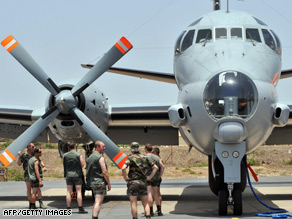Air France 447 - Air France wreckage found in Atlantic Ocean, official says

RIO DE JANEIRO, Brazil (CNN) -- A debris field in the Atlantic Ocean is wreckage from Air France Flight 447, Brazilian Defense Minister Nelson Jobim said Tuesday.

Crew members of a French maritime patrol aircraft prepare Tuesday to search for the missing jet.
Earlier Tuesday, searchers found an airplane seat, an orange life vest, small white fragments, an oil drum and signs of oil and kerosene about 700 kilometers (435 miles) northeast of the Fernando de Noronha archipelago, Brazilian Air Force spokesman Jorge Amaral said.
There was not enough material to officially say it is wreckage from Flight 447, Amaral said.
The debris was found 80 kilometers (50 miles) east of the plane's expected flight path, another Brazilian Air Force official said. ![]() See map of suspected crash zone »
See map of suspected crash zone »
Fernando de Noronha is an archipelago of 21 islands about 355 kilometers (220 miles) off the northeast coast of Brazil.
An earlier report by a crew from the Brazilian airline TAM, who said they saw "shiny spots" in the sea along the route of Flight 447, also prompted a search in the territorial waters off the African nation of Senegal. Senegal is northeast of Fernando de Noronha and also near the plane's presumed flight path. ![]() Watch how wreckage has been spotted in Atlantic »
Watch how wreckage has been spotted in Atlantic »
Ten Brazilian Air Force aircraft were conducting the search.
Don't Miss
A U.S. Navy P-3C Orion airplane will join the search later Tuesday, the U.S. military said. The maritime patrol aircraft and its 21 crew members arrived in Brazil on Tuesday from its forward operating location at Comalapa Air Base, El Salvador, where the plane was supporting illegal trafficking detection operations, the military said.
The Air France plane has built-in homing devices that may help searchers find it, but that could take up to a week, said Greg Feith, a former investigator with the U.S. National Transportation Safety Board.
Homing devices such as "pingers," which are underwater locator beacons attached to flight data and cockpit voice recorders, can transmit signals from as deep as 14,000 feet.
The average depth of the Atlantic Ocean is about 12,000 feet: more than 2 miles.
"They're water-activated, so if they're sitting at the bottom of the ocean, of course, then the military assets will have to go in there with listening devices and try and home in on those particular signals," Feith said.
Factors such as the amount of time since the accident and the speed of ocean currents will determine how long it may take to locate the wreckage, if the debris is confirmed as being from the plane.
"What they're going to have to do now is some reverse engineering, find out the location of this debris. Then they're going to have to figure out what the tide speed was. It's been around now for 28 hours. Now they're going to have to back up that course probably several hundred miles to the actual area of the wreckage," Feith said.
The Airbus A330, which was flying at 35,000 feet and at 521 mph, encountered heavy turbulence early Monday, about three hours after beginning what was supposed to be an 11-hour flight from Rio de Janeiro to Paris, France, according to the airline.
The plane carried 216 passengers -- 126 men, 82 women, seven children and a baby -- and 12 crew members, Air France said.
The majority of the people on the flight came from Brazil, France and Germany. Other victims were from 29 other countries, including two from the United States. Of the crew, 11 were French and one was Brazilian. Read more about the passengers
One passenger held dual citizenship with the United States and another nation but was traveling on the other passport, the U.S. State Department said Tuesday. State Department spokesman Robert Wood did not identify the passenger or give other details.
An official list of victims by name was not available Tuesday afternoon, but two Americans on board -- Michael Harris, 60, and his wife, Anne, 54 -- were identified by the couple's family and his employer.
Prince Pedro Luis de Orleans e Braganca, a member of Brazil's non-reigning royal family, was also on the flight, his family said Monday. Pedro Luis was 26.
Also on the flight were two executives of the French tire company Michelin: Michelin Latin America President Luiz Roberto Anastacio and Antonio Gueiro, director of informatics.
The jet was 4 years old and had last undergone routine maintenance April 16. ![]() Watch report on what could have caused aircraft to go down »
Watch report on what could have caused aircraft to go down »





